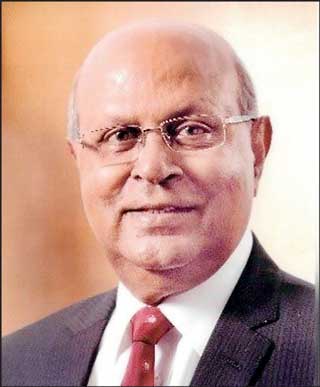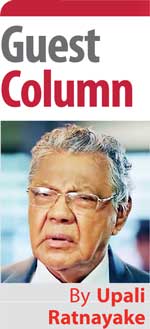Monday Dec 08, 2025
Monday Dec 08, 2025
Friday, 13 May 2022 00:00 - - {{hitsCtrl.values.hits}}
 |
| Prof. M.T.A. Furkhan
|
By 1965 much change had occurred in the socio-political environment of Sri Lanka. Policies that were pro-western had quite violently been overtaken by socialist thought. Nationalisation of many private sector enterprises, the entry of rural masses to administration through universal free education and the reorganisation of Government institutions and the dethroning of English as the main language of administration had brought about vast changes in every avenue of life.
The profession of Accountancy was not widely known and practised in Sri Lanka in the first half of the 20th century but in 1959, Parliament passed an Act establishing the Institute of Chartered Accountants which formalised their presence in the business community to provide financial guidance and for promoting the theory and practice of Accountancy.
However, the British body, The Institute of Cost and Works Accountants was present in the country even though it was not formally organised. Members of ICWA were working mostly in the private sector while the Chartered members dominated the Government sector.
With this backdrop it was obvious that the Chartered members had greater visibility and were consulted in Governmental, financial, monetary and tax issues.
In the country that was going through violent changes, a group of 21 Cost and Works Accountants came together in 1965 to form The Ceylon Association of Cost and Works Accountants and to sign an agreement forming an Association, which was later to be duly incorporated by the Registrar of Companies. At this time, the Cost Accountants were convinced that they, even though they had an internationally recognised qualification, were not adequately recognised in the country. 
A lead figure in this group, Prof. M.T.A. Furkhan who was working at Walkers convinced members that their future lay in coming together to work for their profession. With him were P.N. Wickeremasuriya, M.V. Theagarajah, Karthkeyar, P.S. Mahawatte and several others. Prof. Furkhan invited Frank Hayhurst, an English Cost Accountant working at Walkers also to join. It was this group that drove the profession of Cost Accountancy forward.
Hayhurst was invited to be the first President. The signed document was the authority the members had of the incorporation of the Association. Later in the 1980s Prof. Furkhan presented the framed parchment of signatures which he had preserved, to the office. The Council decided that it should be hung at the head of the Council room. It is now a very valued document in their possession.
There was so much personal commitment among the early members. They spent their own resources in promoting the qualification. They provided text books, internships and working opportunities to new recruits. Prof. Furkhan donated a cupboard to house the textbooks. This was the first piece of furniture that the office had. It is still preserved in the office.
Gradually, Prof. Furkhan and the Committee established a small office for students and members to transact business. They hired an office assistant to serve the growing numbers. With meagre resources and using their own funds they worked towards increasing the membership.
To begin with they didn’t have a permanent abode. They moved from Maitland place to Thunmulla and to Skelton Road. With each move the office space too became larger to cater to the growing student population who wanted more study space and more text books. The head office in London saw the growing popularity of the qualification and willingly allocated a modest grant for Sri Lanka.
In addition to overseeing the Association’s office work, Prof. Furkhan undertook teaching the recruits. He was a totally committed teacher who wanted to see the best accountants come out of the system. Along with him there were other members too who engaged in teaching. This was unpaid service.
With growth, The Ceylon Association became the Sri Lanka Branch while in London the Body changed its name to Institute of Cost and Management Accountants. Prof. Furkhan held office and served in several capacities. He chaired several committees in addition to being President. He contributed to all seminars and conferences organised by ICMA. He was instrumental in inaugurating The National Conference series which came to be a looked forward to event by the entire business world.
Prof. Furkhan and the Council were able to obtain the patronage of the highest Government dignitaries and leading business magnates for their events. They organised their major events with sponsorships received from the business community where Management Accountants served. Prof. Furkhan was able to command respect in the corporate world.
By 1987, ICMA had grown in stature. The Branch was performing well. In 1985, at an ICMA competition, the Sri Lanka Branch was considered the best ICMA Branch in the world and was awarded a cash prize. Tissa Mannakkara, the incumbent President went to England at his own expense to receive the prize.
Now ICMA members commanded respect and had amply shown the business world they could deliver. So much so that, when they asked the Government for land to construct a building to house the secretariat, they complied and allocated 25 perches at Elvitigala Mawatha. The Council however was divided in accepting this offer because they wished for a more central place. However, there did not seem to be an alternative and the Council accepted the offer. Associated with Prof. Furkhan were Muzzamil, Mannakkara, and Suraj Fernando.
When the building was complete and the Council was ready to move, there was also a major development in London. In 1986 London again changed its name to The Chartered Institute of Management Accountants together with a new logo in recognition of the Charter they received in 1975. Thus, in 1987, when the building came to be opened, the new name and logo emblazoned the walls of the building. It was purpose built to house study space and a large library with space for administration. Sri Lanka Branch was made a division with greater control of its affairs. Members of Council worked late into the night planning every detail. Lakshman Hettiaratchi led the designing of student furniture that was to be made out of a new material – treated rubberwood.
This was the first and only freehold building CIMA had anywhere in the world and London took a great interest in it. The President and an entourage arrived from London for the Opening Ceremony in 1987. Prof. Furkhan, Lakshman Hettiaratchi and M.V. Theagarajah were the senior members who welcomed the delegation. The Council was able to invite the President of the country J.R. Jayawardana, and Minister Gamini Dissanayake, the minister who enabled the Council to obtain land, for the ceremony. This was a great victory for CIMA. It showed that it had achieved the recognition it sought under Prof. Furkhan’s direction.
Thus, Prof. Furkhan and the Council were able to obtain the required visibility for CIMA. Its members came to be greatly respected, consulted, and were appointed to high places. London made Sri Lanka a regular destination in their professional itinerary. They were proud of Sri Lanka’s achievement and called the country “The jewel in the crown of CIMA”.
There was no doubt that Prof. Furkhan’s devotion to Management Accountancy was the bedrock on which CIMA’s success was founded. He, even though he had an onerous task in running a hotel chain, gave up his time and strength to CIMA. He was very regular in attendance at all meetings and he never spoke out of the point. He was always ready to help fellow accountants and very ready to point out errors if the Council ever went astray. Today’s members owe him a word of thanks for elevating the profession through which they remain at the helm of the profession.
(The writer can be reached via email [email protected])